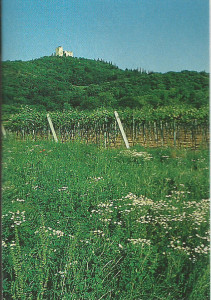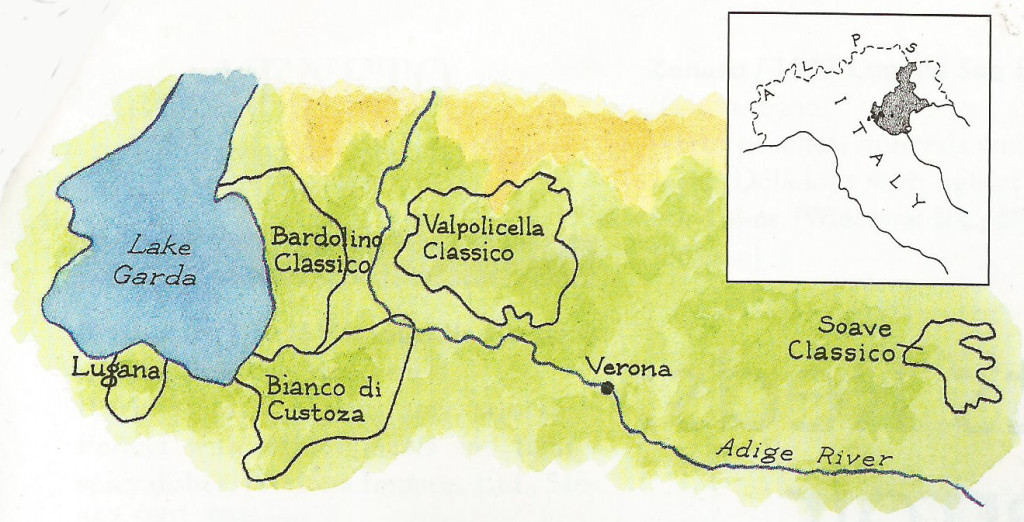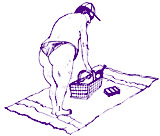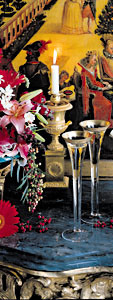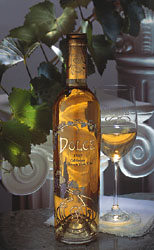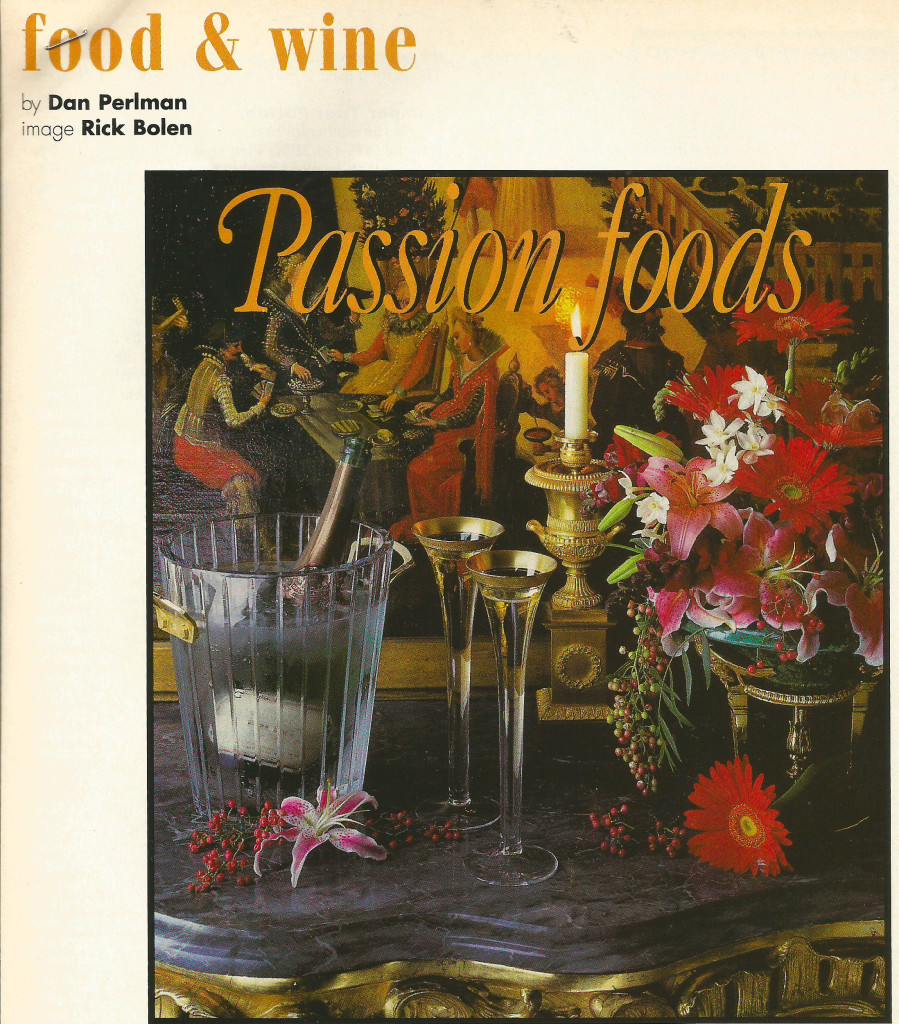Wine & Spirits
Fall 1997
Guide to Understanding Wine & Food
Pages 59-65
WINE & Pork
Dan Perlman, with Lidia Bastianich and Chef Fortunato Nictora
I remember as a child how the slaughtering of pigs was a ritual.” Lidia Bastianich, proprietor of Felidia Ristorante, recalled her hometown in Istria as we prepared for this pairing of pork dishes and wine. “It was usually in November, a unified effort amongst neighbors helping each other to feed their families. Every day another courtyard, every day another pig, until every household had the prosciutto and sausages drying in cantine – the fat rendered and the bacon curing. Every part of the animal was used – the hoofs, the tail, even the ears. Everything was edible and ultimately eaten, except for the bladder – the boys were given that. They would hang it to dry overnight. the next day with a straw they would fill it with air, tie it tight and play soccer with it.”
For most of us raised in America, the only pork we’ve seen is neatly wrapped in cellophane in the local market, or possibly hanging in a butcher shop – a tasty pink meat with relatively low fat content. Personally, growing up a good Jewish boy in the Midwest, I never tasted ham until my late teens when my best friend’s mother served up “pink chicken” one night. But somewhere in the process of becoming a chef and sommelier, eating everything and anything becomes de rigueur.
According to Lidia, “Basically, any preparation that is done with veal can be done with pork. A pork scallop or thin slice of boneless pork can be a very quick and tasty answer to a meal – just make sure not to overcook it! There is always a preoccupation in cooking pork well, but if over-cooked it becomes dry. The meat is made safe to eat when the inner temperature reaches 170°. If you do not have a thermometer, pierce the thickest part of the meat – the juices should run clear with no traces of pink when the meat is fully cooked. For the roasts it is important not to overcook. For the chop recipe here, if you simmer it for a longer time over low fire the meat will reabsorb some of the cooking juices and be tender and tasty.”
Pork, like veal and chicken, in and of itself is an easy match for wine. It is light enough to go with whites, and, depending on the preparation, is still strongly flavored enough to go with everything from light to full-bodied reds. When I help people select wines to go with their meals, I like to consider the main ingredient, in this case pork, separately from the accompaniments, such as sauces, cooking methods and vegetables. The particular cut of meat starts me in the direction of overall style of the wine.
Roast Loin of Pork with Rosemary
In the first of our three recipes, we started wit the idea of a simple roast of pork with rosemary. Your butcher can cut a loin roast from a center rib roast, but, as Lidia explains, it’s easy to do it yourself: “Set the meat on the backbone with the ribs sticking up. With a sharp boning knife start from the far end and work towards you, pressing the knife close to the ribs. In easy strokes cut all the way down until the meat is free of the bones. Whether you debone yourself or let the butcher do it, always reserve the bones. Cut them in smaller pieces and add them to the roast with the vegetables. They will add much flavor. The rib roast will come with a layer of fat on the outside. With a sharp knife shave most of it off, leaving a thin layer which will protect the meat from drying out while cooking.”
The roast, being a solid piece of meat, set us to looking for a nice solid wine. We sought out wines that would either harmonize or contrast with the flavors of the roast. Sometimes you want the food and wine to blend together in a smooth, flowing melody and sometimes you want them to play slightly against each other, like musical counterpoint – or, for those of us from the Midwest – dueling banjos.
Chardonnay Straight and Oaked
Callaway 1996 Temecula Calla-Lees Chardonnay, $10
Lindemans 1996 Padthaway Chardonnay, $12.99
Lees-aged or oak-influenced, these two chardonnays provide plenty of stuffing for the roast. Which style offers the best match?
Our first choice was to work with a pair of whites. The style we had decided on called for a good, solid chardonnay. We chose to try the roast with both a California and an Australian chardonnay – their typically intense extraction of fruit would provide the balance for the herbs. As Lidia puts it, “There is a certain butteriness to chardonnay that is evident here, which works well with lean pork.”
The Callaway Calla-Lees shows exactly the qualities we sought, even without any oak treatment. It is dry, has a lot of fruit flavor, and just a touch of buttery flavors from aging on the lees. There is a very interesting herbal, almost grassy character that works perfectly with the rosemary in the dish. For Lidia, “The pork is very aromatic, between the fennel and rosemary. The Callaway has a nice acidity, but very understated.”
Lindeman’s Padthaway Chardonnay also works well with the roast, but for different reasons – contrasts. In this case, the wine is notably drier and leaner, its oak treatment providing a tighter structure. Lidia notes that “The Lindemans has a ripeness of fruit. It is austere and doesn’t grow in the mouth. Because of that, maybe it is a wine that could be drunk throughout the whole meal.” Chef Fortunato also particularly likes this match: “The dish is a little bit sweet – the garlic and vegetables – with the sweetness of the wine it becomes a bouquet in the mouth.”
Tuscan Traditions
Melini 1994 Chianti Classico Isassi, $13.25
Fassati 1991 Vino Nobile di Montepulciano Riserva, $13.99
Sangiovese is a classic match for this dish. Is a young wine or a more mature Riserva the best choice?
Roast pork with rosemary is a dish that might easily be associated with Tuscany, and this is where we looked next for our first pair of reds. The major grape of Tuscan reds is the sangiovese, and while it can be styled from simple to complex, and light to full bodied, it is at its best when produced in a simple, medium-bodied style.
Fassati’s Vino Nobile di Montepulciano in and of itself is a delicious wine. It has a toasty note, probably from aging in slightly charred oak barrels, that responds to “the crispy bits” of the roast. It is, however, much more tannic than Melini’s Chianti. Tannin is a protein that needs some fat from the food to balance it, and in this case, the roast is too lean to provide a sufficient amount. As Lidia puts it, “There is a little dissonance with the Montepulciano.”
Melini’s Chianti Classico Isassi is softer and spicier than the Vino Nobile. As it turns out, the structure of the wine is in perfect harmony with the structure of the dish. Lidia finds no dissonance of tannins here, and describes the Chianti with the roast as “a duet of violins that are following each other note for note. The Chianti is picking up the Tuscan-ness of the dish. There is a definite affinity between this preparation and the wine – the starchiness of the white beans makes the Chianti sweeter. The rosemary and sage brings it all together.”
The Chianti so far is the stand-out with this dish, but there are still plenty of occasions for the first two whites we tasted. “I would use wines in season,” Lidia suggests. “Chardonnay in the summer or fall, and in the wintertime Chianti is a perfect match.”
Alpine Jazz
Volpe Passini 1992 Colli Orientali del Friuli Refosco Zuc di Volpe, $18
Giacomo Conterno 1995 Dolcetto d’Alba, $20
Two vibrant reds from the foothills of the Italian Alps point toward acidity rather than tannin. How do their structures change the perception of the roast?
I was still thinking Italian when I chose the third pairing. I wanted to move back to the simpler style, but put in something that would jazz up the meal. Sometimes you want harmony and sometimes you want counterpoint. We chose two classic, light and simple reds from the north of Italy – refosco from Friuli, and dolcetto from Piedmont.
The Volpe Passini Refosco immediately provides that counterpoint. It tastes young, rambunctious and vibrant, or, as Lidia puts it, “The refosco is like a young man of twenty-four. It has a rebelliousness. In the context of the meat, it has a lot of activity in the mouth that works on the tastebuds. It awakens them rather than mellows, it adds a vivaciousness. It tells the herbs, ‘let’s go out and play now.'” Rather than harmonizing, the wine and the roast take turns on your palate – much like a jazz combo – each one providing a backdrop while the other one takes the stage.
There’s also an appealing young vibrancy in Giacomo Conterno’s Dolcetto. It has a round, mellow character which Lidia compares to “a young man at age twenty-eight to thirty. The dolcetto works very well with the beans – there is a sweetness. It is not assertive, but very fundamental. It really just depends on what you want in a meal.” At the same time, it provides nuances all its own that add to the overall experience of the dish – for the musical analogy, this match is like a string quartet, all the flavors just weaving in and out of each other. In truth, though by a very close margin, this is our pick of the six wines with this roast.
Roast Loin of Pork with Prunes
The second dish that Chef Fortunato prepared for out tasting was a roast loin of pork with prunes. This is a festive dish that I would personally associate with holidays and cold weather. We had an interesting premise in deciding on the wines for this dish. As Lidia pointed out, sometimes you want the wine to exalt the food and sometimes you want the food to exalt the wine.
Champagne’s Main Event
Taittinger 1992 Champagne Brut Millésimé, $51.99
Domaine Carneros 1991 Brut, $19.99
A light California sparkling wine bubbles up with a richer Champagne. How do they play on the roast?
Thinking in a festive vein, I picked two sparkling wines. Rather than play off two rival houses, I decided to go with two wines from essentially the same producer – Taittinger announces its proprietary interest in Domaine Carneros prominently on the label. Most people don’t think of sparkling wine to go through the dinner, but, as Lidia said, “If you want to carry a Champagne throughout the meal, this is one dish that can do that very well. It’s a challenge – Champagne reacts differently with each course.”
Domaine Carneros ’91 Brut is a well-made yet simple sparkler that is perfect for letting the loin stand on a pedestal. It has a clean, crisp style that helps lighten the heavier fruit sauce, while there’s also a good amount of fruit that works well with the very same sauce. Overall, its fruit and herbal qualities play up the whole dish and really make for a delightful experience.
The Taittinger ’92 Champagne, by contrast, becomes the focus of the pairing. It is a rich, austere wine that immediately competes with the roast. Much like the “jazz” experience of the Refosco with the roast pork, there is a back-and-forth element going on. In this case, the pork becomes the background notes, providing a chance for the wine to be the star.
Lidia’s summary: “The Champagne has a completeness of its own, while the California wants something to go with it. The California sparkler elevates the taste; it’s more scintillating.”
Wild & Mild
Prunotto 1996 Barbera d’Alba Fiulot, $19.50
La Famiglia Mondavi 1994 California Barbera, $18
This rambunctious young Italian and more mellow, ripe Californian express different aspects of barbera. Does the richly fruited pork want subtlety or splash?
Barbera is one of my favorite Italian grapes. A classic in north and central Italy, it is probably at its best in Piedmont. It has an appealing fruitiness and crisp acidity, and I thought that, like the sparkling wines, it would work well. Recently, numerous California producers have begun producing high-quality barbera, and the stylistic differences between the regions provide an interesting contrast.
La Famiglia Mondavi Barbera is part of the new line of Italian varietals introduced by the Mondavi winery. The rich fruit and touches of oak “fill in the holes” in the dish, as Chef Fortunato puts it, and make the whole experience seamless. This is a great example of a wine that exalts the food.
On the flip side, the 1996 Prunotto Barbera d’Alba Fiulot takes over the stage with a display of vibrant fruit, crisp acidity and intense flavors. The pork and the rich fruit sauce become the bass line, while the wine becomes the dominant, though slightly sharp, melody for the meal. For Lidia, that sharpness is too much: “The Prunotto is nicely made, but the nature of Barbera is to be rambunctious, and the acidity is too high for this dish. There is an underlying tartness. The Mondavi is not pretentious. It is harmonious and mellow – you can go on eating and drinking and not have to pay a whole lot of attention to it.”
Of Raisins and Prunes
Nino Negri 1994 Valtellina Sfursat 5 Stelle, $36
Tommasi 1990 Amarone della Valpolicella Classico, $42.50
These two wines are made from air-dried grapes. Will their intensified flavors overpower the dish?
The idea of a rich, concentrated fruit sauce led me to think about the same style of wine. Italians are famous for wines made from air-dried grapes – whether dessert wine such as Vin Santo and passito, or rich, red table wines including Amarone and Sfursat features in this flight.
Tommasi’s Amarone from the ’90 vintage is a delicious wine all on its own. It is made in the Valpolicella region of the Veneto from grapes that are dried on large tarps in well-ventilated attics, the pressed in January. This technique of appassimento helps to create the deep prune character of the Amarone, here matched by the sauce from the roast. The wine’s richness and depth of flavor are supplemented by the sauce. A fine Amarone needs, and here receives, a rich dish to support it and really make it shine.
Nino Negri’s Sfursat 5 Stelle is one of the best examples of the style available. The wine comes from the Valtellina area in Lombardy, better known for wines like Inferno and Sassella. The local nebbiolo grape (famed for its role in Piedmont’s Barolo and Barbaresco) is dried and the pressed to make a rich, concentrated wine. Despite the alcohol level and richness of flavor, the style is elegantly modulated, perhaps more elegant – and certainly lighter – than the Amarone. The plummy, spicy character on the palate absolutely blends into the dish, in some ways becoming a second sauce that is similar yet subtly different from that of the meat.
On finishing both, Lidia summarized, “The Sfursat is harmony with complexity. It’s an extension of the sauce. The Amarone makes a crescendo, it magnifies the flaavors. They provide two different experiences, and both go very well with the dish.” The Amarone stands in the foreground, while the Sfursat has a more intriguing interaction with the dish – fresh prunes rather than dried cherries. For us, that complex interaction makes the Sfursat and this roast the number one food and wine match of our entire tasting.
Piquant Pork Chops
Lidia recommends rib chops for this recipe, although a loin chop can also be very good. Have your butcher cut it for you – all the chops should be as close in size as possible, so the cooking time is equal.
Spicy dishes present a difficult challenge with wine. In this dish, the pickled cherry peppers provide a heat that can throw tannic wines off balance, and an acidity that can make even a high-acid wine taste flat. This high-spirited dish needs a high-spirited wine to match it, an opportunity for friendly competition between the food and wine. Both need to challenge the palate, yet, at the same time work together as a team.
Aromatic & Dry
Gundlach-Bunschu 1996 Sonoma Valley Rhinefarm Vineyards Gewürztraminer, $10
Glen Ellen 1995 Santa Clara County Expressions Viognier, $10
Varietal character is the main contrast with these two Californians, as well as an element of oak. Can these aromatic whites stand up to the piquant pork chops?
Aromatic grapes were a necessity in choosing our pairings. I started with two of my favorites, gewürztraminer and viogner. The former is probably best known from Alsace, the latter from the Rhône Valley. To gain a little more assertiveness, and just a touch of sweetness that wines from those regions tend not to have, I looked to California. In the end, this flight of wines provided the most controversy and split decisions for out tasting panel.
The Gundlach-Bundschu Gewürztraminer is a spicy, crisp and clean wine that provides all the aromatic elements that work with the garlic, peppers and herbs in this dish. There is a delicious element of fruitiness that is accented by those same strong flavors that we really enjoyed. And as Lidia noted, “it clears the fat of the dish away” with its solid acidity and strong flavors.
The Glen Ellen Viognier is part of this winery’s new Expressions line of varietal wines. the variety provides some wonderful aromatic elements that work with all the competing flavors that the piquant sauce contains. And this particular wine adds a healthy dose of American oak that provides a distinctly coconutty element. This puts an interesting twist on the dish, blending with the garlic and peppers to produce a suace that has a vaguely Thai taste to it, and, as Lidia puts it, “the Viognier is not scared by the pepperiness of the dish.” Chef Fortunato and I find the viognier is slightly too oaky for the dish, while Lidia particularly likes the match. You can expect some sparks to fly when you taste this flight.
Aromatic & Sweet
Dr. Bürklin-Wolf 1995 Pfalz Forster Ungeheuer Riesling Spätlese, $18
Domaine Aubusiers 1993 Vouvray Demi-Sec, $10
When sweeter chenin blanc and riesling meet this dish head on, is there any hope of a marriage?
For this flight, our thinking was to take the same sort of aromatic elements but add in some sweetness to counterbalance the spiciness of the sauce. We moved on to two other aromatic varieties – riesling and chenin blanc – and chose wines that are off-dry to medium sweet.
A Vouvray demi-sec is our off-dry entry. The crisp, green apple aromatics of chenin blanc fruit on their own are delicious, and those fruit flavors work very nicely with this dish. The sweetness, however, throws off the balance of the match. You might consider the sec (dry) bottling of the same producer, to further investigate the possibilities with chenin.
Bürklin-Wolf’s Riesling Spätlese Forster Ungeheuer is an absolutely delicious example of medium-sweet riesling, mouth-filling, and, regrettably for this dish, even sweeter than the Vouvray. The underripe peach and mineral flavors worked admirably with the piquant sauce, but there was not enough perceived acidity in either the wine or the dish to balance the high sugar levels. Again, consider the Kabinett level from the same producer with this dish – or seek out a Spätlese halbtrocken.
In both cases, the flavors of these wines work with the dish, but their sweetness overpowers the acidity and spicy levels in the dish. As Lidia puts it, “There’s no common denominator.” This flight is not only an interesting exercise in food and wine matching, it’s also a reminder that even professionals make mistakes.
The Red Solution
Navarro-Correas 1992 Mendoza Malbec, $13.50
Nelson Estate 1992 Sonoma County Cabernet Franc, $16
Aromatic red varieties add new variables to the spice equation. How does the dish respond to red wine tannins and acidities?
It is common wisdom that spicy dishes require white wines because, in general, red wine grapes do not have the spicy aromatics needed to balance them. I’m not one of the people that subscribe to this common wisdom. Aromatic red grapes are, perhaps, a bit more off-beat, but are often delicious in their own righ tand well worth a little added effort to find.
Malbec is Argentina’s top red variety, and the rendition from Navarro-Correas happens to be one of my favorite wines for drinking at home. It has a peppery, spicy and herbal quality that beautifully matches the aromatics of the sauce. It is dry yet rich in fruit, with soft tannins, and all in all combines to make a delightful experience.
The Nelson Estate grows cabernet franc, an ancestor of the better-known cabernet sauvignon, in Sonoma County. Cabernet franc has an aromatic, dried herb and green olive character that you either love or hate, and one good way to find out is to taste this particular wine, which is one of California’s best examples of the variety. Those strong characteristics are a great match for the similarly strong garlic and pepper qualities in the sauce. The wine also has a nice touch of toasted oak that blends well with the caramelization from the sauté process.
Chef Fortunato preferred the cabernet franc match, enjoying “the way the wine smoothes out the spiciness of the dish.” Lidia and I, on the other hand, preferred the malbec and Lidia summed up the experience: “The cabernet franc is well-tempered. It has enough backbone to carry the capriciousness of spicy pork. The cabernet is fine, but I prefer the malbec with the pork because of all the spices it has. The cabernet is full, but of a single note. The malbec is a myriad of tastes.”
While Lidia’s recipes demonstrate how pork is a mainstay of Italian cuisine, there are many other possibilities with pork, from various Asian traditions, to other European and American cultures. Like a blank musical staff, many notes can be written there, and they come in many forms. Sauces, condiments, herbs, spices, cooking methods all provide a different experience to the dish, and so should the wine. You just have to decide if it’s a jazz, classical, pop, or opera sort of evening….
Following are Lidia Bastianich’s recipes that were used for this tasting:
Roast Loin of Pork with Rosemary (Arrosto di Maiale alla Fiorentina)
2 cloves garlic, minced
4 sprigs rosemary, 2 minced plus 2 whole
⅔ cup fresh fennel and leaves, chopped
3 tablespoons extra-virgin olive oil
salt and freshly ground pepper
2 pounds boneless, rolled pork loin, with a thin layer of fat*
⅓ cup diced carrot
⅓ cup diced celery
⅓ cup roughly chopped onion
2 cups chicken stock
* If the pork loin is one solid piece, make a deep incision along the grain, along the long side – you should be able to open the meat as you would open a book. Spread the filling on the internal surface, close to the original shape and tie tightly.
Preheat the oven to 450°. In a mortar or blender make a rough paste with the garlic, minced rosemary and fennel, 2 teaspoons of the olive oil, salt and freshly ground pepper to taste.
Spread half the herb paste inside the meat, roll tightly and tie. Thread the remaining 2 sprigs of rosemary through the twine on either side of the roast. With a skewer, make holes in the top and sides of the meat and fill them with the remaining herb paste. Season with salt and freshly ground pepper, place in a roasting pan and coat with the remaining olive oil. Place in the oven and roast 15 minutes.
Reset the oven to 400°. Remove the meat from the oven, drain the fat from the pan and scatter the vegetables around the meat. Return the pan to the oven and roast for 15 minutes. Add the stock and continue to roast, basting periodically, for about 40 to 45 minutes more. For complete safety, the meat should reach an internal temperature of 170°, but 155° to 160° will provide a juicier roast.
Remove the roast to a serving board. Pass the vegetables through a sieve or food mill, along with the pan juices; skim the fat and reduce the sauce if it is too thin, adjusting the seasoning as necessary. Slice the roast and serve with the warm sauce, with a side of white beans if desired. Serves 4.
Roast Loin of Pork with Prunes (Arrosto di Maiale alle Prugne)
6 ounces dried prunes, pitted
⅓ cup bourbon
2 pounds boneless, rolled pork loin, with a thin layer of fat*
8 fresh sage leaves
salt and freshly ground pepper
3 tablespoons olive oil
3 cloves garlic, crushed
⅓ cup diced carrot
⅓ cup diced celery
⅓ cup chopped onion
2 cups chicken stock
* If the pork loin is one solid piece, make a deep incision along the grain, along the long side – you should be able to open the meat as you would open a book. Spread the filling on the internal surface, close to the original shape and tie tightly.
Soak the prunes in the bourbon for 1 hour. Preheat the oven to 450°. Drain the prunes and spread them on the inside of the loin, reserving 3 to 4 of them as well as the liquid. Roll the loin tightly, place the sage leaves on the outside of the meat and tie. Season with salt and freshly ground pepper, place in a roasting pan and coat with the remaining olive oil. Place in the oven and roast 15 minutes.
Reset oven to 400°. Remove the meat from the oven, drain the fat from the pan and scatter the vegetables around the meat. Return the pan to the oven and roast for 15 minutes. Add the stock and continue to roast, basting periodically, for about 40 to 45 minutes more. For complete safety, the meat should reach an internal temperature of 170°, but 155° to 160° will provide a juicier roast.
Remove the roast to a serving board. Pass the vegetables through a sieve or food mill, along with the pan juices; skim the fat and reduce the sauce if it is too thin, adjusting the seasoning as necessary. Slice the roast and serve with the warm sauce. Serves 4.
Piquant Pork Chops (Costolette di Maiale Piccanti)
4 lean pork chops, bone in, ¾-inch thick
flour
salt
3 tablespoons olive oil
8 cloves garlic, crushed
2 pickled cherry peppers
1 sprig fresh rosemary
2 tablespoons wine vinegar
¼ cup dry white wine
1¼ cups chicken stock
Dredge the chops in flour, removing any excess, and season with salt. In a wide, heavy skillet, cook the chops in hot oil until golden brown. Add the garlic; when it is lightly browned add the cherry peppers and rosemary and stir. Drain excess fat. Add the vinegar, cook for 5 minutes, then add the wine and cook for 5 minutes more. Add 1 cup of chicken stock, cover and simmer for 15 minutes, turning occasionally and adding remaining stock as needed. Remove the chops to a serving dish and strain the sauce over them. Serves 4.





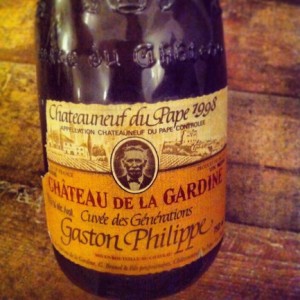 And now, my own little awards show. The Oscars for best wines of 1999. All votes are my own and do not reflect the whims of the Academy. These are wines that should be currently available – I didn’t think it fair to include older wines that may be impossible to find. Sample them yourself and cast your own votes.
And now, my own little awards show. The Oscars for best wines of 1999. All votes are my own and do not reflect the whims of the Academy. These are wines that should be currently available – I didn’t think it fair to include older wines that may be impossible to find. Sample them yourself and cast your own votes.